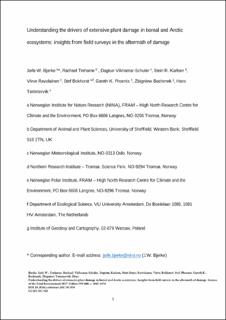| dc.contributor.author | Bjerke, Jarle W. | |
| dc.contributor.author | Treharne, Rachael | |
| dc.contributor.author | Vikhamar-Schuler, Dagrun | |
| dc.contributor.author | Karlsen, Stein Rune | |
| dc.contributor.author | Ravolainen, Virve | |
| dc.contributor.author | Bokhorst, Stef | |
| dc.contributor.author | Phoenix, Gareth K. | |
| dc.contributor.author | Bochenek, Zbigniew | |
| dc.contributor.author | Tømmervik, Hans | |
| dc.coverage.spatial | Noreg, Norge, Norway, Svalbard | en_US |
| dc.date.accessioned | 2023-06-19T13:24:34Z | |
| dc.date.available | 2023-06-19T13:24:34Z | |
| dc.date.created | 2017-05-24T13:13:29Z | |
| dc.date.issued | 2017 | |
| dc.identifier.citation | Science of the Total Environment. 2017, 599-600 1965-1976. | en_US |
| dc.identifier.issn | 0048-9697 | |
| dc.identifier.uri | https://hdl.handle.net/11250/3072091 | |
| dc.description.abstract | The exact cause of population dieback in nature is often challenging to identify retrospectively. Plant research in northern regions has in recent decades been largely focussed on the opposite trend, namely increasing populations and higher productivity. However, a recent unexpected decline in remotely-sensed estimates of terrestrial Arctic primary productivity suggests thatwarmer northern lands do not necessarily result in higher productivity. As large-scale plant dieback may become more frequent at high northern latitudes with increasing frequency of extreme events, understanding the drivers of plant dieback is especially urgent. Here,we report on recent extensive damage to dominant, short, perennial heath and tundra plant populations in boreal and Arctic Norway, and assess the potential drivers of this damage. In the High-Arctic archipelago of Svalbard,we recorded that 8–50% of Cassiope tetragona and Dryas octopetala shoots were dead, and that the ratios of dead shoots increased from 2014 to 2015. In boreal Norway, 38–63% of Calluna vulgaris shoots were dead,while Vacciniummyrtillus had damage to 91% of shoots in forested sites, but was healthy in non-forested sites. Analyses of numerous sources of environmental information clearly point towards a winter climate-related reason for damage to three of these four species. In Svalbard, the winters of 2011/12 and 2014/15 were documented to be unusually severe, i.e. insulation from ambient temperature fluctuation by snow was largely absent, and ground-ice enforced additional stress. Winter climate change Plant mortality Extreme events Cryosphere Pest Tundra | en_US |
| dc.language.iso | eng | en_US |
| dc.rights | Attribution-NonCommercial-NoDerivatives 4.0 Internasjonal | * |
| dc.rights.uri | http://creativecommons.org/licenses/by-nc-nd/4.0/deed.no | * |
| dc.subject | Winter climate change | en_US |
| dc.subject | Plant mortality | en_US |
| dc.subject | Extreme events | en_US |
| dc.subject | Cryosphere | en_US |
| dc.subject | Pest | en_US |
| dc.subject | Tundra | en_US |
| dc.title | Understanding the drivers of extensive plant damage in boreal and Arctic ecosystems: Insights from field surveys in the aftermath of damage | en_US |
| dc.type | Peer reviewed | en_US |
| dc.type | Journal article | en_US |
| dc.description.version | acceptedVersion | en_US |
| dc.subject.nsi | VDP::Matematikk og Naturvitenskap: 400::Zoologiske og botaniske fag: 480 | en_US |
| dc.source.pagenumber | 1965-1976 | en_US |
| dc.source.volume | 599-600 | en_US |
| dc.source.journal | Science of the Total Environment | en_US |
| dc.identifier.doi | 10.1016/j.scitotenv.2017.05.050 | |
| dc.identifier.cristin | 1471849 | |
| dc.relation.project | Andre: Polish-Norwegian Programme of the EEA Norway Grants (WICLAP) | en_US |
| dc.relation.project | Framsenteret: 362222 | en_US |
| dc.relation.project | Norges forskningsråd: 225006 | en_US |
| cristin.unitcode | 7511,4,0,0 | |
| cristin.unitname | Tromsø | |
| cristin.ispublished | true | |
| cristin.fulltext | postprint | |
| cristin.qualitycode | 2 | |

